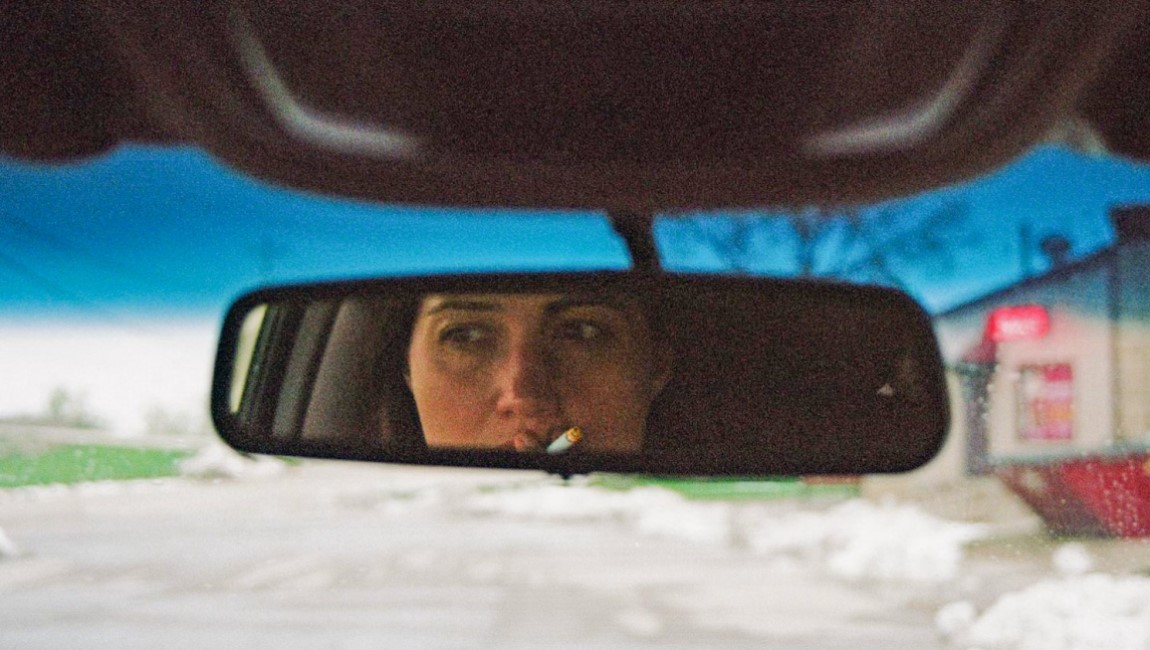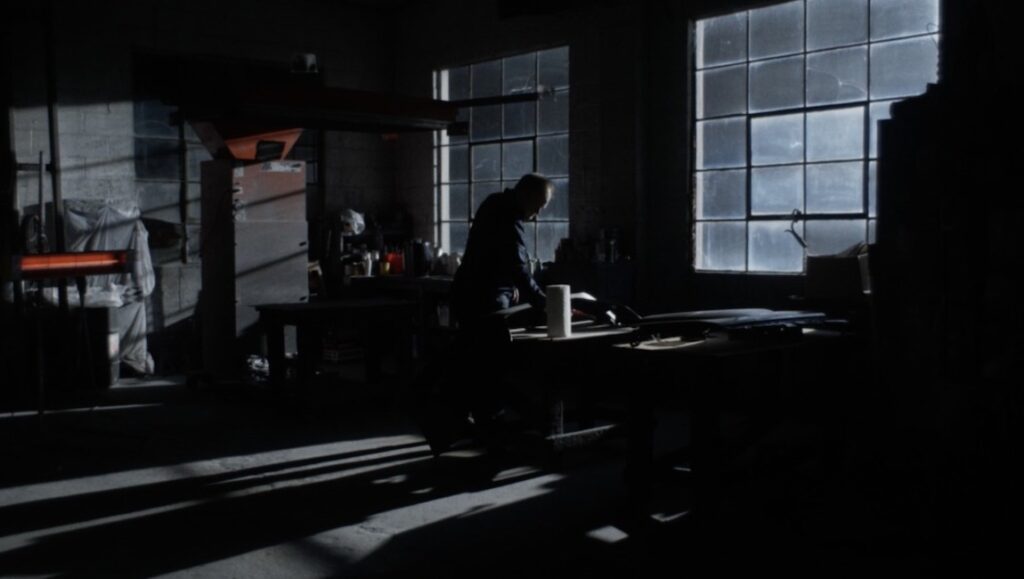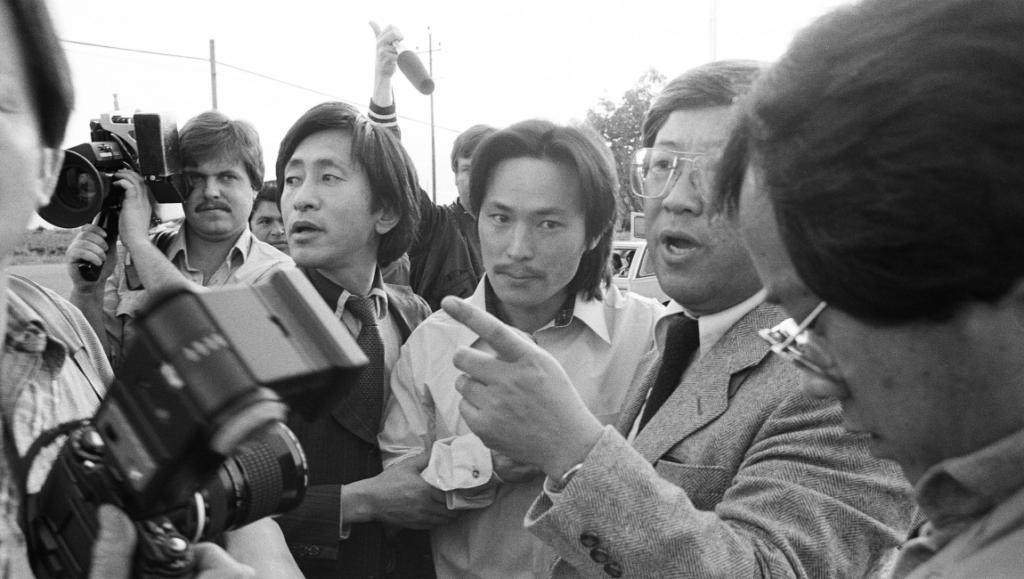The Unknown Country
Non-fiction scenarios and non-professional actors are often characterized as so rich and unpredictable that all a director needs to be is a receiver for what percolates in everyday life. But the world is full of contrivances, and a hack director can latch onto them as uncritically as a hack screenwriter will in the racing hours before production dates arrive. In the case of Morrisa Maltz’s The Unknown Country, a curious hybrid between these two approaches gives us a well-made narrative of grief, heat-pressed over the conveniences of interview-based non-fiction storytelling. In effect, it renders everything fictional. Lily Gladstone, for most of the movie the only professional actor on-screen, is sleeping out of her car on a spur-of-the-moment road trip after the death of her grandmother, with whom she was particularly close. (The exact proximity is left for a third-act reveal.) Along the way, she meets the proprietors of diners, gas stations, and dives, at which point the movie will seamlessly enter into a mini-portrait mode (with expositional interviews, each arriving at one moving anecdote, playing over shots of Gladstone inaudibly improvising her way through these encounters). It’s uneven, though it never sinks the movie.
That instead comes with the film’s title conceit, which seems to be a direct response to the NY Times style of reportage that swooped in on Middle America circa 2017 to produce portraits of aggrieved ambience away from the coasts. Like any intrepid explorer, Maltz has embarked with a set idea of what she’ll find in this project, and it’s a world of media narratives: KILI Radio reports on Trump, Epstein, and soybean shortages serve as transitional dispatches, Gladstone acts as a kind of interviewer of all she finds, and indie radio hits from the mid-2010s (Beach House, Slowdive, and Sarah Neufeld) soundtrack the high points of each charmingly banal episode. There’s a stronger narrative strand that enters the picture, in which Gladstone’s character (“Tana” in the credits, scare-quotes included) reunites with family for the occasion of a wedding. But this is handled just as clumsily, not in the sense that this isn’t Gladstone’s “real” family, or that the performances might not be as effortless as some other “hybrid” films, but that Maltz is uninterested in dealing with the problem her film has opened up. If we are presented with a narrative that produces a significant amount of doubt, the challenge isn’t to find a more uplifting smile, but to start somewhere else than the question that is thought to hide behind the screen-filling shot, early on, of a roadside American flag.
Writer: Michael Scoular
Happer’s Comet
While technically a “Covid film,” shot on weekends with friends and family during the first wave of lockdowns in early 2020, Tyler Taormina’s Happer’s Comet doesn’t have any designs on grand, how we live now statements. Instead, the technical and logistical issues of making a movie during a pandemic have seemingly seeped into the aesthetic of the actual object itself. Transporting the moody, elliptical storytelling of his first feature, Ham on Rye, onto an even more sparse canvas, Taormina conjures a somnambulist journey through a single night in a nondescript suburban enclave. Everyone here is isolated, every space eerily liminal, until quiet moments of tender connectedness, at last, coalesce in the film’s final moments.
That being the operating mode, there’s virtually no story here to synopsize, as Taormina instead scribbles a series of potential narrative threads around the film’s margins through cryptic, privileged moments. The opening credits play over an extreme close-up of a rotting ear of corn; the camera then begins languidly panning across dark living rooms, empty foyers, and basements, rendering these familiar, lived-in spaces almost alien. A young man furtively applies makeup while alone in his bedroom, while an older man preens in front of a mirror, obviously still proud of his aged physique. An elderly woman nods off in her kitchen, while another shot follows a family dog as it traipses around the house. There are no establishing shots, no recognition of when we are leaving one home and entering another. It is instead a sort of mosaic, occasionally interrupted by recurring shots of a police cruiser prowling the streets with its spotlight on, the bright light source beaming into homes through half-closed blinds. Another scene finds a man trying not to fall asleep behind the wheel of his car; the automobile drifting toward a median creates an immediate tension, a fissure in the otherwise calm mood.
There’s a casual surrealism to the endeavor, perhaps not a surprise to anyone who saw Ham on Rye, with its strange central conceit. Gradually, a number of people begin putting on rollerblades and quietly exiting their homes, as if drawn to some unknown beacon. Indeed, this is a film of apparitions, the mundane suburban milieu rendered otherworldly and ghostly. It’s all the more lovely, then, when Taormina ends his film with a series of embraces, various couples enmeshed in a cornfield and each other’s bodies. Here, finally, is a concrete, tactile recognition of human interconnectedness. Like a mysterious dream that begins to dissipate upon waking, Happer’s Comet feels like stumbling around and blindly reaching out in the dark, and the sweet waves of relief at finding someone still next to you. It’s a deeply beautiful piece of work.
Writer: Daniel Gorman
Ferny & Luca
Andrew Infante’s Ferny & Luca is a first feature with a lot of places to get to. It briskly orbits around romantic ideas and images, indulges in city symphony rhythms, and thrills in the idea of an expressive camera. Before it sets up its title pairing, it must first state its real intent: to capture Brooklyn — loners, partiers, streets, skies, all — through handheld jutters, sudden push-ins, establishing zoom-outs, split-screens, wide-screens, aspect-ratio changes, and other sundry forms of what might be classified as formal enchantment. The pace is off-kilter, the structure tangential; events, once Luca (Lauren Kelisha Muller) takes up Ferny (Leonidas Ocampo) on his offer of a drink after her DJ set, are leaped past or lingered over in a way that deliberately runs away from the typical interests of romantic comedy.
While Infante’s tendency as an editor is to hold off the spectacle for patient long-takes of roommate intimacy, the overall sense is that we’re rushing toward something. It isn’t resolution or ecstasy, though the soundtrack drops (including an unforgivably underlined one from Oklou) try to make a point. It isn’t heartbreak either, though we get a glimpse of each character, including Omari (Cameron Mitchell Mason), a seemingly assured foil to Ferny, at some terminus of dissatisfaction. The rushing, it turns out, might be the whole point: the feeling of movement, of activity, of precise references and emotional swings. The temporary lift that pop expression can provide is, however, a tough deal to make good on: it demands extremes if it won’t be contrasted or transmuted by narrative. Infante goes for broke in a coda, exhausting a store of city-in-transit images, but, surprisingly, there is little weight or sense of departure in this move. It’s a tribute, maybe, to the iconic simplicity and wonder of the nose-pressed-to-window view of the world. But it’s also an easily justified kind of avoidance: to say away with words, play the hits, and let the questions of genre recede in the rearview.
Writer: Michael Scoular
Free Chol Soo Lee
Calling Free Chol Soo Lee timely is almost an understatement. The directorial debut of Eugene Yi and Julie Ha, it’s a documentary dedicated to the life of Lee, a Korean American living in San Francisco’s Chinatown who, in 1973, was framed by the police for the contract killing of a Chinese gang leader and served the next ten years of life in prison, with five on death row for a prison killing in self-defense. The efforts to free him were enacted on both the national and international stage, as a Defense Committee was formed to raise attention and work on securing a trial and proper representation for him, while he himself took on an almost iconic form as the symbol of Asian-American injustice.
In order to draw out both the Kafkaesque situation (invoked explicitly in the film) and the genuinely stirring sense of solidarity that coalesced, Free Chol Soo Lee tells Lee’s story from essentially cradle to grave (he died in 2014) while also constantly bringing in key figures that recur throughout the film, including close friends, journalists (like his first advocate K.W. Lee), and attorneys. Many of these people, including of course Lee himself, are largely represented through archival interviews and recordings, though Lee’s thoughts about himself and his predicament are compiled from his notes and rendered in voiceover by Sebastian Yoon.
The one deviation from this chronological march is an enlightening one: Free Chol Soo Lee begins immediately with Lee’s immersion in Chinatown and his arrest, before leaping back to his birth on the occasion of his first interview with K.W. Lee. Yi and Ha very much establish their film as an investigation of sorts, making the progression of details and characterization of both legend and movement come to life in the assemblage of archival footage and voiceover; there’s a palpable sense of melancholy that comes through in Lee’s resignation to his circumstances, his own navigation between the confidence and gratitude he shows in his charismatic interviews and the doubt over his self-worth in prison.
All of this comes to the fore in Free Chol Soo Lee’s final act. Once Lee is freed from prison, he suffers from the whiplash between the isolation of death row and the celebrity he has accrued, and once the world tour dries up, he falls prey to addiction and an inability to integrate into the society that had worked to free him. This part of the film, thankfully, sees his struggle not as a failure of moral character, but as a symptom of a less obvious systemic failure, one that makes maintaining even a single nonprivileged person’s lifelong wellbeing an inordinately difficult task. The final part sees him reformed in the aftermath of a botched arson attempt and bringing hope and passion once again, but the feeling of grief continues to permeate. There’s certainly much still unexplored — the almost total lack of Chinese interview subjects, everyone’s choice to refer to Lee by his Americanized name order — but Yi and Ha’s act of excavation, of linking Asian-American oppression and resistance to the modern day without ever explicitly bringing this decade into the conversation, is deeply moving.
Writer: Ryan Swen
100 Ways to Cross the Border
When Jean-Luc Godard launched the experimental Dziga Vertov Group with Jean-Pierre Gorin in 1968, one of their primary concerns involved creating radical texts that eschewed bourgeois, capitalist norms of film production and dramaturgy — to make “political films politically,” as they put it. The problem, then, was how to get viewers interested in these works, so determined were the filmmakers to deny any of the traditional “pleasures” of cinema. Here, form and content intertwined to the detriment of the casual movie-goer, i.e., the very proletariat that Godard and Gorin wished to reach (and persuade). A similar issue arises with Amber Bemak‘s new documentary 100 Ways to Cross the Border, which introduces audiences to performance artist Guillermo Gómez-Peña and his outré dance/art troupe La Pocha Nostra. A deeply political thinker, Gómez-Peña attempts to literalize the US/Mexico border and map it onto his own body. He declares borders, like nationality, as porous, fluid constructs, each patrolled and militarized by governments (and by extension fascists). For her part, Bemak takes this another step, blurring the line between director and subject, inserting herself freely into her film and even occasionally ceding control to Gómez-Peña. Call it mimetic filmmaking, a good-faith effort to expand form to the ever-changing shape of its subject. But does it go far enough?
The film begins with standard-issue footage of Gómez-Peña and his collaborators, among them Balitrónica Gómez, Michèle Ceballos Michot (“the aging ballerina”), and others. Together they imagine, rehearse, and perform what Gómez-Peña calls “political topography,” illustrated via bodies in motion and spoken-word tracts. Indeed, he calls the body an “art-fact,” a living metaphor. At a very brief 84 minutes, 100 Ways to Cross the Border could stand to be substantially longer. What we get instead is a kind of primer, a slew of ideas and sketches that evoke a potentiality more than anything else. Talking head interviews with Gómez-Peña reveal a curious, engaged, occasionally angry artist, while copious amounts of both archival and newer footage show bits and pieces of various performances. But one wishes we could see an entire uninterrupted sequence (indeed, a scene of Michot dancing around a pool that ends with her interacting directly with the camera is a playful show-stopper), even while the footage we do get is still evocative. A jumbled mix of punk rock outfits, leather gear, and Indigenous accouterment, along with props and ample nudity, quickly inform viewers that nothing is off-limits. One sequence shows Gómez-Peña pointing an assault rifle at the audience, intercut with him telling Bemak about all the different times he’s crossed the border to the US. The nicer he dressed, he tells her, the more likely he was to be “randomly selected” for a secondary inspection. But once he began dressing as a mariachi, an entertainer, the Border Patrol agents became less threatening, treating him like a harmless pal.
Gómez-Peña is determined to explore, and explode, these racist cliches and caricatures. He remarks that he’s performed at international art shows and film festivals without a single other Hispanic person in sight, and that despite winning dozens of awards and various accolades, he can barely pay a mortgage. It’s heavy stuff, which Bemak jazzes up with animated interludes, snappy montage, and humor. It’s important to convey that Gómez-Peña and his collaborators are also having fun; scenes of rehearsals and free-form improv reveal a group of artists seeking inspiration from anyone and anything. Bemak gets in on the fun herself by shedding her clothes and billing herself as the “naked director.” Her banter with Gomez-Peña is jovial but still pointed — he calls her an “East Coast, Jewish intellectual” who’s just an outsider, while she calls out his pretensions. It’s pretty obviously staged, but it brings up real concerns about cultural tourism and appropriation. Which is to say that there’s much to mull over here, perhaps even too much. 100 Ways to Cross the Border can feel disorganized at times: its chapter headings are arbitrary, and plenty of lines of inquiry get cut off before they’re explored with any real depth. Still, it’s all refreshingly playful, and an obvious labor of love for those involved. Gómez-Peña and his troupe are invigorating company, and an essential, anarchic rejoinder to our current fraught political climate. They’re out there fighting the good fight, and more power to them.
Writer: Daniel Gorman
2nd Chance
Ramin Bahrani, once again, has something to say about the state of the modern-day American Dream. That “something,” per usual for him and many filmmakers of his ilk, is re-stating the plainly obvious in all caps and with some choice underlining: capitalism is BAD (more like crapitalism, amirite?), everything nowadays about profits and percentages, and because of these two broad axioms, we’ve lost our mutual humanity as a result. But Bahrani seems to think that we as a collective audience haven’t gotten it yet, even after an onslaught of post-Big Short exercises in telling us how we’re blind idiots to corporate greed; this may also help explain why each of his recent feature-length melodramas has become more didactic in terms of spelling all of this out. The absolute nadir of this type of moral handwringing was, at first, At Any Price, a complete and utter misfire (and a Roger Ebert 4-star) about the supposed sinister world of seed patents, which was practically dead on arrival with a central topic that bland — it also happened to feature one of Dennis Quaid’s most buggin’ performances. That was, the nadir until 99 Homes came along with a cigar-twirling Michael Shannon to hammer it all home even further, ending with a literal machismo-heavy screaming match that would make the likes of Nicholas Ray blush.
Now there’s 2nd Chance, Bahrani’s first foray into documentary filmmaking after last year’s The White Tiger — which somehow secured him his first screenwriting Oscar nomination — that operates in the same blunt-force register as his narrative ones. He even went to the trouble of spelling out via voiceover narration what should be the doc’s subtext, but who needs that when you have an audience to educate? “What drew me to Richard were his contradictions,” he pensively states within the first ten minutes, worried that we might not get that some rich asshole is a walking inconsistency unless he flat-out tells us. The Richard in question — who’s the central subject of the doc as a whole — is human reptile Richard Davis, a once failed Detroit-based pizzeria owner who later invented the first bulletproof vests made of kevlar and eventually founded Second Chance, a body armor manufacturing company based out of Northern Michigan. In order to promote his new technology, Davis would travel to local police stations and “test it out” by shooting himself point-blank in the chest while wearing said vest; as Bahrani also mentions, “In 500 million years, Richard Davis is the only man to shoot himself 192 times,” a factoid that, like much of the information provided throughout, really doesn’t connect with much else going on beyond initial shock and awe.
We learn a lot more about Richard: that he directed a number of 8mm “educational” films about the many lives that his vest saved, all of which fudge key details for maximum entertainment value; that while he treated many members of his staff like family, he has no qualms about dumping people the second they become invaluable; and while he cries on camera at the thought of the untold number of lives that his vest could have saved if he had invented it sooner, he was directly involved in a massive public scandal involving Zylon-based vests that his company knew were defective, yet still mass-produced for piggies around the country. All of these brazen lies are stacked on top of one another, yet Bahrani never can quite tie it all together beyond being bewildered by the state of it all. He’s clearly amazed that a creature like Davis can/does exist and tries to nail him on his hypocrisies several times over — but he always comes up empty-handed, as men like Davis really couldn’t care less if their mistruths are exposed so long as they ultimately got away with it (the same issues plagued The Act of Killing, who’s director, Joshua Oppenheimer, is credited as a producer here). “His story is a metaphor for the country,” Bahrani also spoon-feeds audience members, and to a degree, he’s certainly right — yet, considering how obvious this all is in hindsight and how little this will change in the present, who really cares? It’s the cinematic equivalent of screaming into the wind, getting angry for anger’s sake, proving that, sometimes, the most productive thing one can say is simply saying nothing at all.
Writer: Paul Attard
The Feeling of Being Close to You
There’s a brazen messiness to Ash Goh Hua’s The Feeling of Being Close to You that’s hard to ignore. The short film, which was the major highlight of BAMcinemaFest’s two shorts programs, is positioned as an autobiographical work that deals with intergenerational trauma. Any sort of healing or reconciliation isn’t so neat, though, or even really achieved. Hua corrals old VHS home videos from when they were a child, and the images are juxtaposed with a present-day phone call with their mother. The film begins with a blunt retelling of a dream: “I dreamt that you wanted to hug me. When you hugged me in the dream, I felt like I was suffocating. It wasn’t comforting or consoling. Instead, it felt like I couldn’t move or breathe.” It explains the frayed understanding of physical intimacy that Hua has with their mother, and immediately colors the footage we see as something less cheerful than it appears.
The true power of Hua’s film is in this subversion of expectations. Writer Emily St. James recently observed the “millennial parental apology fantasy” trend that’s animated works such as Everything Everywhere All At Once and Turning Red, but Hua understands this as a fictitious ideal, one that makes the process of restoration seem easier than it really is. At times, it’s obvious that Hua is wielding the camera as a weapon, as documentarians often do (explicitly or not): they contrast images from when they were a child to contemporary footage, including when they’re celebrating their birthday and getting their hair braided. The people around them in both these periods are completely different — Hua was born in Singapore but now lives in New York — and they’re telegraphing that this is the safer, better reality they’ve chosen.
There’s a multitude of emotions swirling throughout The Feeling of Being Close to You, and it’s never more clear than when Hua replaces VHS tapes with images of the ocean. It’s over these abstracted black-and-white glimmers of light that we hear Hua’s mother apologize and acknowledge her mistakes, and even get a bit defensive. There’s bitterness and anger and hurt and confusion, and this rawness of emotion is the point — it’s difficult for Hua’s mother to say all this, and being able to sense that makes the conversation all the more moving. When she explains that she wants to give her daughter happiness, Hua retorts, “I don’t think that’s what I need.” It harkens back to a specific paradox: Hua’s mom used to beat them, but she also wanted to protect them from a school principal who threatened physical harm. This is the conflict at hand: different understandings of love across generations and cultural divides, and being able to navigate that. Even halfway around the world, Hua knows that doing so is painful.
Writer: Joshua Minsoo Kim










